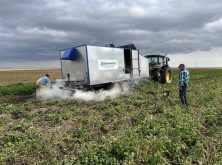Q: Where are all these weeds coming from?
A: Despite our best management practices, we will never eliminate weeds from our fields. Weed seeds will continue to find their way onto our fields in not so mysterious ways.
Excluding volunteer crops, the most significant ways new weeds move onto our fields is by wind, water, animals or equipment.
To move by wind, weed seeds typically have specialized wings, plumes or a tumbling plant structure. Unfortunately for us, these features are common among some weeds on the Prairies. The result is weed seeds blowing in and settling in depressions or getting caught
Read Also

Claas brings 1000 Series SP forage harvesters to Canada
In mid-August, Claas unveiled its new line of Jaguar forage harvesters at an event in Visalia, California, deep in the heart of that state’s dairy region.
in stubble. Although the distance from a mother plant to your field can be kilometres, most of the wind-distributed seeds are probably travelling less than 10 metres and are common along field margins. Significant weeds that move this way are kochia, dandelion and foxtail barley.
Weeds that move with water tend to be moisture-loving species like scentless chamomile and willow species, but any lightweight seed that moves by wind can easily move with water. You will find these weeds throughout your field along waterways.
Animals — big or small, by foot or wing, wild or domesticated — all contribute to new weeds in our fields. Small rodents will carry seeds onto fields for winter storage, while larger animals and waterfowl tend to excrete a percentage of viable seeds in feces.
One of the most common ways for weed seed movement is by equipment. Seeing thistle or quackgrass pop up in straight lines from roots travelling on tillage equipment is possible. Combines also spread weed seeds like smartweed species, green foxtail or any weed species that matures at a similar time as our crops. These weeds tend to show up at field entries when equipment is engaged or in areas of rough terrain where seeds are dislodged from cracks.
When weeds are spotted in fields, best management practices like rotating crops, applying herbicides and controlling weeds when they are small are recommended. Utilize proper chemical application techniques in combination with mechanical control when necessary.
Nathan Trowell, CCA, PAg, is a manager of agronomic services with Nutrien Ag Solutions in eastern Saskatchewan.















